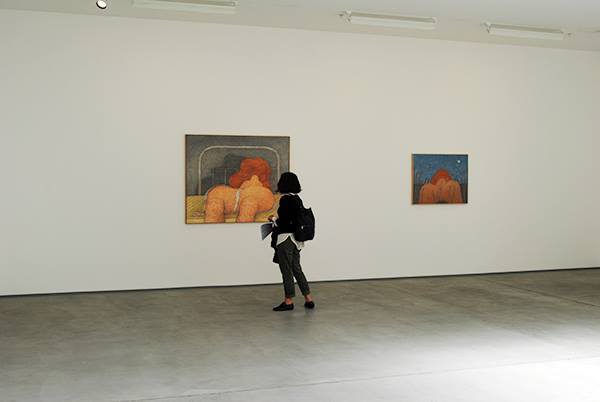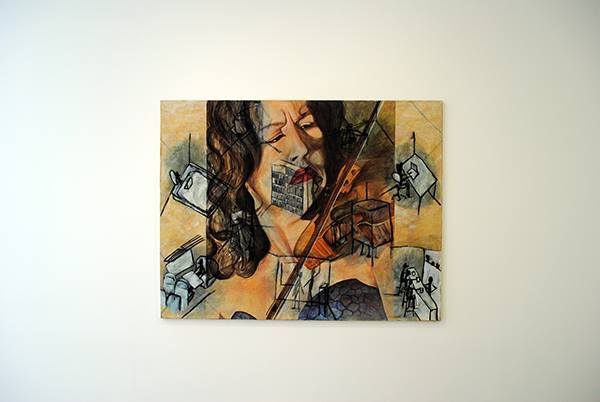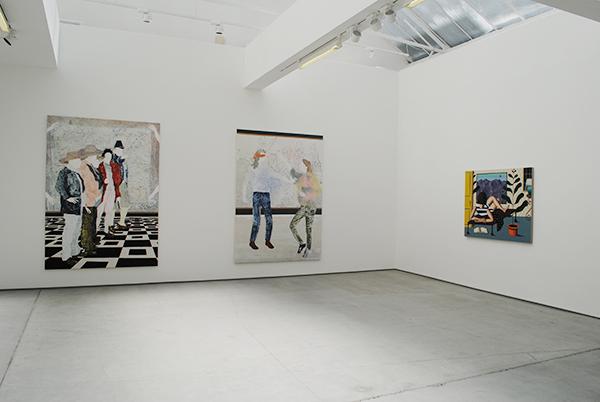Sadie Coles HQ presents ‘June: A Painting Show’, its summer group exhibition of contemporary painting comprising the work of fourteen international artists of varying ages – including works from late painters – consisting primarily of figurative works spanning five decades.
 Co Westerik, Woman on bed, 1994, tempera, alkyd and oil on canvas, site size: 119.7 x 197.5 x 3 cm P A Black © Artlyst 2015
Co Westerik, Woman on bed, 1994, tempera, alkyd and oil on canvas, site size: 119.7 x 197.5 x 3 cm P A Black © Artlyst 2015
Co Westerik studied at the Royal Academy of Art in The Hague, where he also taught life drawing from 1958 to1971. An expert on the human form, his poetic compositions of everyday situations are conveyed through lyrical, delicate brushstrokes, and evoke a sensibility of loneliness and sorrow. The flattened, distorted and truncated anatomies transport explicit episodes of everyday life into a dreamlike narrative realm. The sexualised body – a naked figure outdoors, or a naked woman lying on a bare mattress – is mapped onto a decorative plane, its contours or orifices reimagined in strangely lyrical terms. The evocatively-subdued coloration and distorted anatomies of Westerick’s scenes invoke the quixotic imagery of Edmund Dulac or other Symbolist painters, investing ‘kitchen sink’ realism (as epitomised by Sickert) with a contrary quality of magical realism. Making work in his nineties, Westerik lives alternately in
Rotterdam and the South of France.
 Sylvia Sleigh, Felicity Rainnie Reclining, 1972, oil on canvas, site size: 107.5 x 152.5 x 3 cm P A Black © Artlyst 2015
Sylvia Sleigh, Felicity Rainnie Reclining, 1972, oil on canvas, site size: 107.5 x 152.5 x 3 cm P A Black © Artlyst 2015
Born in Wales, Sylvia Sleigh trained at Brighton School of Art before moving to New York in the early 1960s, where her realist, figurative paintings found prominence in New York’s feminist art scene. This portrait of artist Felicity Rainnie vividly reflects Sleigh’s harnessing of an art-historical trope (the reclining female nude) to a highly personal context, in a portrait of her friend ‘Flip’. The picture was painted in Sleigh’s bedroom, and presents its subject through a combination of intimacy and crisply decorative stylisation. The patterned bedspread, which extends almost seamlessly across the wallpaper to create a swirling yet flattened backdrop, is a William Morris design of the kind that acquired cult popularity in the 1970s – an effusion of cornflowers and green tendrils. Against this Victorian revivalist imagery, conveying a mood of bohemian domesticity, the image of the naked girl is immediate and unflinching, with the clear depiction of the girl’s tanlines running against any sense of the idealised female nude.
 Helen Johnson, The Saboteurs, 2015, acrylic on canvas, 250 x 180 x 3.5 cm P A Black © Artlyst 2015
Helen Johnson, The Saboteurs, 2015, acrylic on canvas, 250 x 180 x 3.5 cm P A Black © Artlyst 2015
Australian painter Helen Johnson makes work that is referential, historically agglomerative and acutely self-reflexive. She has explained that “the approaches I take seek an understanding of painting as a loaded medium operating on new terms in a post-medium condition […] Painting is an interesting vehicle for me because it is loaded, neurotic, problematised, a market force, scattered, and essentialised, loathed, able to operate simultaneously within and beyond itself, able to be beautiful and horrible at the same time.” Critic Andrew Berardini has noted that “the paths and patterns, textures and tones of all her disparate sources come together with a lissom wrist and soft-hued palette that makes its own meaning”.
 Nicole Eisenman, Untitled, 2015, oil on canvas, 119.6 x 197.2 x 4.2 cm P A Black © Artlyst 2015
Nicole Eisenman, Untitled, 2015, oil on canvas, 119.6 x 197.2 x 4.2 cm P A Black © Artlyst 2015
American Nicole Eisenman’s figurative oil paintings toy with themes of sexuality, comedy and caricature. Her compositions often compress multiple layers of history, or art history, into dense multi-figure tableaux reminiscent of history paintings. In this new work from 2015, she translates the luminous colours and flattened design of cartoons or animations into the language of Modernist painting. Banal reality is also succinctly and wryly encapsulated in the charging phone that sits beside the figure’s bed in sleek two-dimensional profile, almost reduced to a pictogram. Eisenman graduated from the Rhode Island School of Design in 1987. With A.L. Steiner, she is the co-founder of the queer/feminist curatorial initiative Ridykeulous.
 Jana Euler, Untitled, 2009, oil on canvas, 140.2 x 180 x 2 cm P A Black © Artlyst 2015
Jana Euler, Untitled, 2009, oil on canvas, 140.2 x 180 x 2 cm P A Black © Artlyst 2015
Jana Euler’s art revolves around the concept of identity as a fragile and mutable construct. Her paintings employ symbolism and translucent layering to encode multiple meanings. Mediating between and conflating figurative and abstract idioms, Euler’s work evinces recurring formal and conceptual concerns – specifically the interface between contemporary technology and art history. Euler was born in 1982 in Friedberg, Germany. She studied at the Staatliche Hochschule für Bildende Künste— Städelschule, Frankfurt, from 2002 to 2008, and at the Glasgow School of Art in 2007. Euler lives and works in Brussels.
Artists: Barbara Rossi, Helen Johnson, Jonathan Gardner, Sylvia Sleigh, Pieter Schoolwerth, Ryan Mosley, Mernet Larsen, Ahmed Alsoudani, Nicole Eisenman, Yamashita Kikuji, Jana Euler, Co Westerik, Rodel Tapaya, Hayv Kahraman.
Sadie Coles HQ – June: A Painting Show – until 15 August 2015

